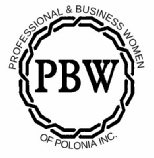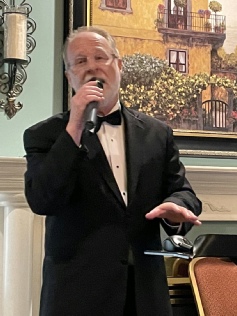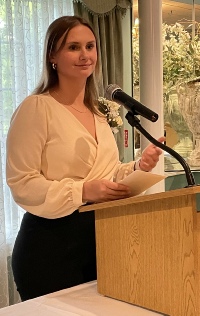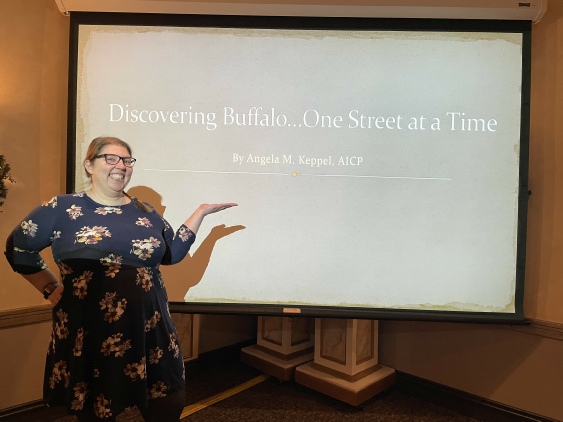












by Dawn Myszka,
PBW Historian
The Professional & Business Women of Polonia (PBW) wrapped up the year with its annual scholarship award and dinner meeting at Kloc's Banquet Facility on May 18. This year's basket raffle included beautiful hanging flower baskets from Seneca Greenhouse and smaller table-
The annual scholarship fundraiser, Scholar-
This year's scholarship recipient was Emma Marzec. She was joined by her proud parents, Christopher and Kathryn Marzec.
Emma is completing her dual major studies in psychology and Spanish at Canisius College where she is also on the Dean's List. Emma is a research assistant and lab manager at Canisius' Memory and Cognitive Lab. Outside of school she is a pool supervisor and lifeguard instructor at the Town of Tonawanda Aquatic & Fitness Center. If that isn't enough, she will be attending law school in the fall.
Every year, the scholarship committee carefully reviews the applications of scholarship applicants and conducts in-
PBW board members were also recognized: Vice President JoAnne Lewandowski, Treasurer Terry Tucholski, Secretary Barbara Wetzel, executive board members Patricia Greiner, Mary Zuk-
A special thank you went to Andy Golebiowski, host of the Polish American Radio Program on WEBR Radio, 1440 AM / 105.3 FM for promoting the PBW on his show. You can listen to Andy's show live Saturday mornings at 11:00 am or anytime online at polishprogram.com.
PBW member Michelle Kisluk announced that the Am-
Before giving the dinner prayer, PBW's own Sister Mary Johnice Rzadkiewicz acknowledged that she will be receiving the Honoree of the Year Award on Aug. 15 during Polish Night at the Buffalo Bisons baseball game. Certainly a well-
After dinner, PBW members and guests were entertained by vocalist Mark Swarts. You may be familiar with his voice. He is the morning radio host of WNED-
He is hands down a seasoned vocalist singing the songs of beloved past crooners such as Sinatra, Martin, Perry Como and Andy Williams and contemporary crooner, Michael Buble. He did not shy away from a request to sing an Elvis song. He sang "Teddy Bear" and nailed it!
PBW board member Patricia Greiner got in the dancing spirit to Engelbert Humperdinck's "Blue Spanish Eyes." I was thrilled when he sang a song by The Osmonds -
"Sailing" by Christopher Cross got people swaying in their seats. A sing-
The next dinner meeting is scheduled for Sept. 13 at the Polish Falcons in Depew. The speaker will be Author Sophie Hodorowicz Knab who will talk about her book "Spirit of Place: The Roadside Shrines of Poland." Come join us.



by Dawn M. Myszka, PBW Historian
What's in a name? Have you ever wondered how the streets of Buffalo got their names? What is the history behind such street names like Wilson Street, Bailey Avenue, Broadway, and many, many others?
Angela Keppel knows. She is an urban planner and a Buffalo history enthusiast. On Nov. 30, 2023 at Ilio DiPaolo's Restaurant and Banquet Facility, she gave Professional and Business Women of Polonia members and guests, including Beth Sardina, a former PBW of Polonia scholarship winner, a Buffalo history lesson. Since 2011, she has written about the origins of the names of close to 200 of the 1,544 Buffalo city streets.
She became hooked on the rich history of Buffalo during her childhood when her mother would take the family to the Buffalo History Museum. Her father had volunteered at the history museum. For the last 20 years, she has also been volunteering there.
She was curious about how Keppel Street got its name being that her last name is also Keppel. Could it be that the street was named after someone in her family? She has done extensive research on its origin but has not uncovered how Keppel Street was named. She did say that it was not named after her father's side of the family.
A big part of Buffalo's history is in the street names. For many years, you may have thought that Wilson Street was named after President Woodrow Wilson. I know that I did. It is very easy to make that presumption as there are other streets close to Wilson Street that are named after United States Presidents (Fillmore Street after Millard Fillmore, Jefferson Street after Thomas Jefferson, Monroe Street after James Monroe, Madison Street after James Madison and Adams Street after Samuel Adams).
Wilson Street was actually named in 1872 after a gentleman named Guilford Reed Wilson, who was a pioneer coal dealer and early member of the Buffalo Board of Trade. The future U.S. President, Woodrow Wilson, was only 16 years old then. What was fascinating from Angela's presentation was that there are three streets named after Guilford Reed Wilson -
I am curious whether future generations will think that Allen Street was named after Buffalo Bills quarterback Josh Allen. Maybe if they win the Super Bowl!
If you have a chance, you definitely should view Angela's website "Discovering Buffalo, One Street at a Time." You can find it at: http://buffalostreets.wordpress.com. The research that she has done on the history of Buffalo's street names is very informative and educational.
Robert Fronckowiak of the Polish Arts Club of Buffalo spoke briefly before Angela's presentation about putting together a spread sheet of all of the local Polish organizations to share their events, Polish history, traditions with others and the community. They are looking for someone to help gather and organize that information online.
Holiday donations by PBW members and guests were made to the Response to Love Center. PBW member, Sr. Johnice Rzadkiewicz CSSF, gave a beautiful dinner prayer for the upcoming Advent season.
In November 2024, the PBW of Polonia will be celebrating its 30th anniversary. We will be planning special events for our dinner meetings and will let everyone know in advance. We hope that you will join us.